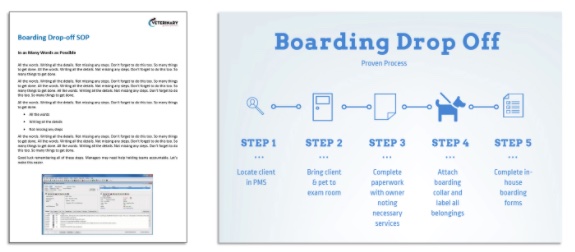
By Rachel Teichberg, CVPM, CVBL, CCFP
I’m sure we’ve all heard the saying “keep it simple, stupid” or The KISS Principle, as coined by the US Navy in 1960. You may have also seen it as “keep it short and simple”, or “keep it short and sweet”. Use whatever words you want, but ultimately the idea is that systems or operations function best when they’re simplified. Unfortunately, what I’ve found in practice is that we have this tendency to overcomplicate things, making it incredibly challenging for our teams to succeed in a stressful environment. If you had any doubt that simple is better, just remind yourself that this term was coined by the Navy, a military operation known for precision and efficiency.
In Pathway Planning, the embodiment of the KISS Principle is through proven processes. Proven processes are essentially a simplified version of your standard operating procedures (SOPs). If you look through your big dusty binder of SOPs, you may have documents that resemble the image on the left in the visual below. It’s too much, it’s too long, and your team can’t remember it. That SOP is making the process unnecessarily complex. Proven processes are created by turning that long SOP into a 3-5 step process. That’s it! You can see on the right how we can easily simplify it into 5 steps.

There are two very important rules when it comes to proven processes: They must be followed by all and if you can’t do the process, you can’t do the job. These two rules will become even more game-changing than writing the processes themselves. First, it eliminates hypocrisy. This is not going to be a do as I say, not as I do situation. All members of the team will be held accountable for the same written process. If someone is unable to perform all steps after training, then they will not be able to do the task until they have proven they can.
I imagine you may be thinking about how many processes you’ll need to write and are starting to mentally prepare for a complete overhaul of your SOPs. My first piece of advice is to take it slow. If you have never written any processes, let’s start with the biggest pain points of the practice. This could be client check-in, refill requests, setting up for surgery, discharging a patient, or receiving a package. Write down all the areas you feel are the top priority and start there. Try to strike a balance between internal (staff) and external (client) processes. Get your team involved, because their perspective will help ensure the proven process is sound and will have their buy-in from the start.
Though it’s tempting to write them all down and roll them out simultaneously, it’s best to only implement 1-2 at a time. This will give your team an opportunity to get comfortable with the new process, commit it to memory, and consistently execute it accurately. Training is key, and it will take more (much more) than just reading the process together at a staff meeting. Have the team role-play it or practice the process. Create visuals like the one above, and provide small, pocket-sized versions for easy access. Check-in with your team, and reward or acknowledge them when the process is followed correctly.
Grab a pen and paper and start generating a list of your priority proven processes. Get your team or the departments together for their input, too! Remember, everyone wants things to be simple and efficient, so let’s see where they feel the opportunities are. Get ready to KISS your problems goodbye with proven process!
About the Author
